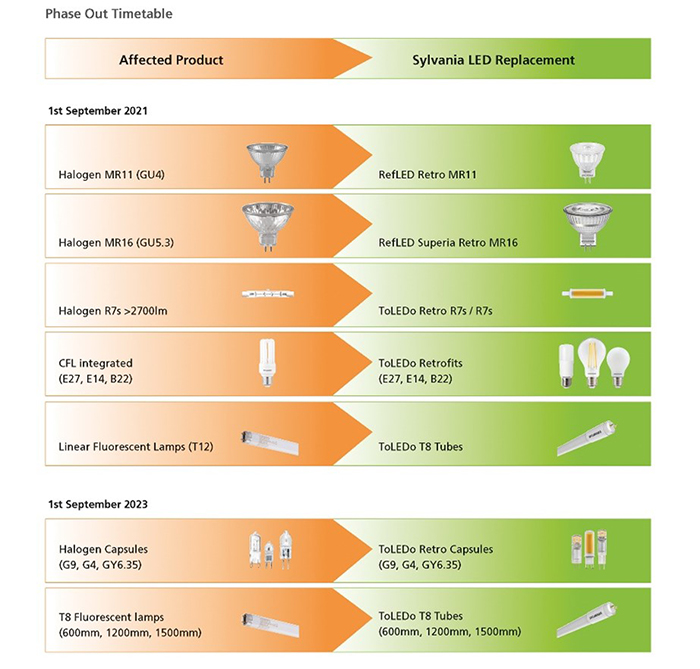Sylvania embraces new lighting regulations
New ground-breaking EU and UK legislation is on track to shake up the lighting industry. A ten-year European government review begins its implementation in a major move to improve product efficiency, protect the environment and boost sustainability for the benefit of consumers.
Sylvania has experience in introducing energy saving light sources, like LED Filament lamps and true retrofit LED GU10 with like-for-like dimensions and the same light output, compared to a 50W Halogen GU10. In complying with the new regulations Sylvania has triggered an overhaul of its lamp products and packaging that is targeted to deliver clarity to customers and lower its environmental impact.
The new Single Lighting Regulations (SLR) and Energy Label Regulations (ELR) will come into effect on 1st September 2021, effectively combining relevant past rules and encompassing all available new lighting technologies. The legislation now simply classifies lighting products as ‘light sources' (lamps, sealed-for life luminaires and modules) and ‘containing products’ (luminaires with replaceable light source or control gear), as opposed to ‘lamps’ and ‘luminaires’.
Therefore, the new energy label regulation which is applicable for light sources – now also applies to lamps, and each light source will be given a new energy rating between A and G. A = 210lm/W through to G = < 85lm/W. This replaces the existing energy label A++ to E. Reclassifying all lamp efficiencies.

The product characteristics of each light source will be published on the EPREL (European Product Database for Energy Labelling) database, with an easy access QR code displayed on packaging that links the end-user to this data. In line with the higher performance threshold, certain existing lighting technologies no longer comply and will be banned.
The SLR set new minimum requirements for lumen efficacy, lumen maintenance, survival factor, flicker and stroboscopic effect. This results in the upgrade of some existing LED lamp technologies and the phase-out of conventional lighting technologies that don’t meet the new requirements:
- Halogen low voltage lamps GU4, GU5.3, G53 as of 1st September 2021
- Halogen R7s > 2700lm as of 1st September 2021
- Compact fluorescent lamps with integrated control gear (E27, E14, B22) as of 1st September 2021
- Halogen G9, G4 and GY6.35 capsules as of 1st September 2023
- T8 fluorescent lamps (600mm, 1200mm and 1500mm) as of 1st September 2023
The environment and sustainability are at the core of the new Single Lighting Regulations and Energy Label Regulations. Although many LED lamps will have improvements to their efficiency, the most visible change is the recalibration of the energy rating scale that is displayed on the packaging. In an important adjustment, regulators have adopted a new scale to allow for a wider scope of efficiency performance.
The current A++ classification will now score a mid-table ‘E’ within a revised A to G range. This will help the drive for even greater efficiency and integrate the principle of circular economy in product development.
Lighting products classified as ‘containing products’ now applies to most luminaires and will no longer require an energy label and are expected to have the features of replaceability and refurbishment, either by the end customer, a qualified electrician, or by the manufacturer where necessary.
The implementation of SLR and ELR has been welcomed by Sylvania, a major brand within worldwide lighting. Strategically the company has coordinated existing projects that target improvements in product efficiency and sustainability with the new legislation, to trigger an important pivot towards a greener future. In response to the new regulations and changes to the display of the energy rating scale, a major redesign of the company’s lamps product packaging was initiated reflecting feedback from both consumers and trade partners.
“The new regulations have provided an ideal opportunity to roll out the company’s universal packaging strategy for lamps, by implementing customer feedback and legislative requirements to enable clear decisions at the point of purchase. We also embrace the opportunity to inspire even higher levels of product efficiency in the future,” commented Anuj Vasu, Segment Head, Consumer at Sylvania. “Along with our eco-friendly packaging we have reduced our carbon footprint by 25% by streamlining the supply chain and the number of SKUs in the range without comprising on the choices available to the customer”.
Major environmental benefits have been driven by a move to a paper and card packaging solution, which uses no plastic. Additionally, this has entailed a move to abandon ‘blister packs’ that were used extensively, especially throughout continental Europe. Ingenious design has delivered all the benefits of Sylvania’s existing packaging using 100% recyclable materials and this will generate an annual reduction of over one tonne of plastic, reducing our carbon footprint even more.
In keeping with the spirit of the new legislation to promote easy access to product information at the point of purchase, Sylvania has taken steps to make its LED lamp packaging more customer friendly. Colour temperature is displayed with an appropriate colour tab and a prominent ‘cap’ identifier is included to improve compatibility. Also, features like dimming functionality are clearly marked on the front of pack.
“As a lighting business, Sylvania is fully aligned with the new SLR and ELR regulations and welcome the focus on higher efficiency and sustainability that these measures will bring. This has also provided us with an opportunity to improve the processes across the business and provide better clarity of choice for customers and deliver tangible reductions in emissions across our logistic networks” explained Simon Reed, Chief Executive Officer (EMEA) at Sylvania Lighting.







